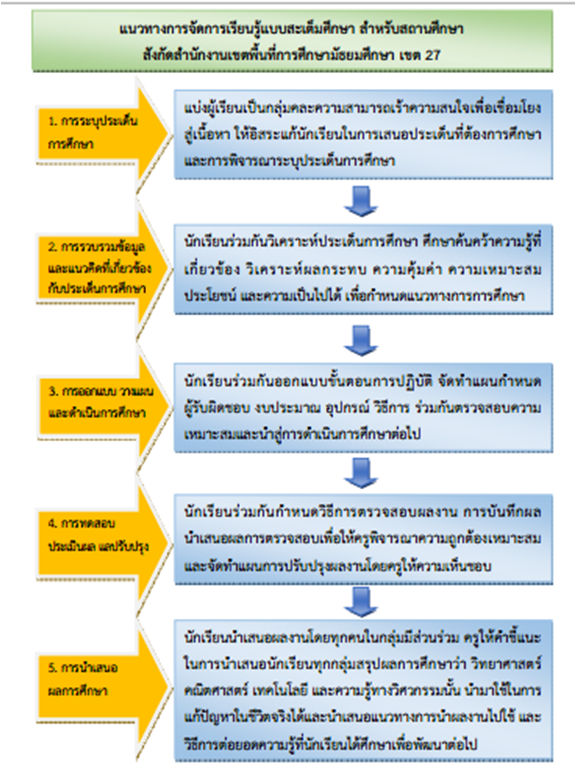DEVELOPING THE STEM LEARNING MANAGEMENT GUIDELINES FOR SCHOOLS UNDER THE SECONDARY EDUCATIONAL SERVICE AREA OFFICE 27
Main Article Content
Abstract
The objectives of this research article were 1) to study the current condition, desirable condition, and the priority needs index of STEM learning management for schools, 2) to develop the STEM Learning Management Guidelines for Schools under the Secondary Educational Service Area Office 27. The sample group consisted of 340 teachers. Data were collected by using the current condition and desirable conditions questionnaire. To develop the guidelines the group of key informants were administrators and teachers of 2 model schools and 7 luminaries for the guideline suitability and the guideline possibility assessment. Collected data by used the review form and the guideline suitability and the guideline possibility assessment form. Statistical used for analysis data included Percentage, mean, standard deviation, and the priority needs index.
The research results were as follows: 1. The STEM leaning management of schools under the Secondary Educational Service Area Office 27 has the current condition overall and all aspects were at moderate levels and the desirable condition overall and all aspects were at high levels, and STEM leaning management of schools under the Secondary Educational Service Area Office 27 descending sort by priority needs index were Design planning and studying, Gathering information and ideas related to educational issues, Testing evaluation and improvement, Identifying educational issues, and presenting the study results. 2. The guidelines of STEM learning management for schools under the office the Secondary Educational Service Area Office 27 consisted of 5 elements 22, indicators, 42 guidelines, with the suitability assess and the possibility assess both overall were at the highest levels.
Article Details

This work is licensed under a Creative Commons Attribution-NonCommercial-NoDerivatives 4.0 International License.
References
กมลฉัตร กล่อมอิ่ม. (2559). การจัดการเรียนรู้แบบบูรณาการสะเต็มศึกษาสำหรับนักศึกษาวิชาชีพครู.วารสารศึกษาศาสตร์ มหาวิทยาลัยนเรศวร. 18(4). 334-348.
คณะวิทยาศาสตร์และเทคโนโลยี มหาวิทยาลัยราชภัฏสกลนคร. (2559). คู่มือการจัดการเรียนรู้ด้วยกระบวนการสะเต็มศึกษา. คณะวิทยาศาสตร์และเทคโนโลยี มหาวิทยาลัยราชภัฏสกลนคร.
ชนกพร จุฑาสงฆ์. (2559). การพัฒนาโปรแกรมการเสริมสร้างสมรรถนะการจัดการเรียนรู้ของครูสังกัดสำนักงานส่งเสริมการศึกษานอกระบบและการศึกษาตามอัธยาศัย. วิทยานิพนธ์การศึกษาดุษฎีบัณฑิต สาขาวิชาการบริหารและพัฒนาการศึกษา. บัณฑิตวิทยาลัย : มหาวิทยาลัยมหาสารคาม.
พรทิพย์ ศิริภัทราชัย. (2556). STEM Education กับการพัฒนาทักษะในศตวรรษที่ 21. วารสารนักบริหาร. 2(2). 49-56.
ราชกิจจานุเบกษา. (2560). รัฐธรรมนูญแห่งราชอาณาจักรไทย. ราชกิจจานุเบกษา เล่ม 134 ตอนที่ 40 ก ราชกิจจานุเบกษา. 6 เมษายน 2560.
วีระชัย ศรีวงษ์รัตน์. (2559). แนวทางการพัฒนาสมรรถนะครูด้านการจัดการเรียนรู้ในสถานศึกษาสังกัดสำนักงานเขตพื้นที่การศึกษาประถมศึกษาอุดรธานี เขต 1. วิทยานิพนธ์การศึกษามหาบัณฑิต สาขาวิชาการบริหารการศึกษา. บัณฑิตวิทยาลัย : มหาวิทยาลัยมหาสารคาม.
สถาบันส่งเสริมการสอนวิทยาศาสตร์และเทคโนโลยี. (2557). ความรู้เบื้องต้นสะเต็ม. กรุงเทพมหานคร :สถาบันส่งเสริมการสอนวิทยาศาสตร์และเทคโนโลยี กระทรวงศึกษาธิการ.
สมชาย อุ่นแก้ว. (2558). วิธีการสอนแบบสะเต็มศึกษา (STEM Education). สืบค้นเมื่อ 24 สิงหาคม 2562. จาก http://www.kids.ru.ac.th/document/KM/STEM_by_T.Somchai-unkeaw.pdf
สำนักงานคณะกรรมการการศึกษาขั้นพื้นฐาน. (2553). แนวทางการดำเนินงานโรงเรียนมาตรฐานสากล. กรุงเทพมหานคร : สำนักงานคณะกรรมการการศึกษาขั้นพื้นฐาน.
สิรินภา กิจเกื้อกุล. (2558). สะเต็มศึกษา. Journal of Education Naresuan University. 17(2). 201-207.
อัญญรัตน์ นาเมือง. (2553). การปฏิรูปการศึกษาของประเทศไทย. วารสารมหาวิทยาลัยนราธิวาสราชนครินทร์. 2(2). 112-121.


